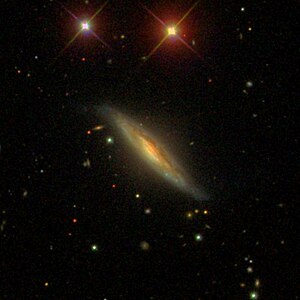NGC 4628
| Galaxy NGC 4628 |
|
|---|---|

|
|
| SDSS recording | |
| AladinLite | |
| Constellation | Virgin |
|
Position equinox : J2000.0 , epoch : J2000.0 |
|
| Right ascension | 12 h 42 m 25.2 s |
| declination | -06 ° 58 ′ 16 ″ |
| Appearance | |
| Morphological type | SA (s) b: sp / Sy2 |
| Brightness (visual) | 13.5 likes |
| Brightness (B-band) | 14.3 mag |
| Angular expansion | 1.7 ′ × 0.5 ′ |
| Position angle | 45 ° |
| Surface brightness | 13.2 mag / arcmin² |
| Physical data | |
| Redshift | 0.009433 +/- 0.000030 |
| Radial velocity | 2828 +/- 9 km / s |
|
Stroke distance v rad / H 0 |
(122 ± 8) · 10 6 ly (37.3 ± 2.6) Mpc |
| history | |
| discovery | Wilhelm Herschel |
| Discovery date | March 20, 1789 |
| Catalog names | |
| NGC 4628 • PGC 42681 • MCG -01-32-041 • IRAS 12398-0641 • GC 3162 • H II 773 • h 1394, 3411 • LDCE 0910 NED004 | |
NGC 4628 is a 13.5 mag bright spiral galaxy (and also a Seyfert galaxy type 2) of the Hubble type Sb in the constellation of Virgo , which is about 122 million light years away from the Milky Way.
It was discovered on March 20, 1789 by Wilhelm Herschel with an 18.7-inch reflector telescope, who described it as "F, S, E, bM".
